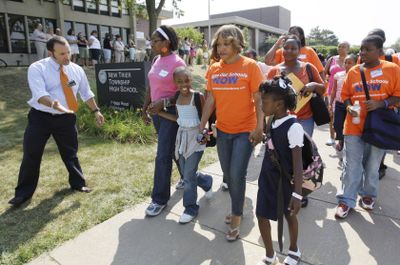Students go to suburb to protest funding inequity
Protest will move to Chicago corporations today

NORTHFIELD, Ill. – More than 1,000 Chicago public school students skipped the first day of classes Tuesday to protest unequal education funding, a boycott organizers said would continue through the week with help from retired teachers who will turn office lobbies into impromptu classrooms.
The students took church buses 30 miles north to the wealthy suburb of Northfield, where they filled out applications to enroll in the better-funded New Trier district. The move was largely symbolic because students must pay tuition to attend a school outside their home district.
The turnout fell short of the thousands organizers expected, and was a tiny fraction of the more than 400,000 students who attend Chicago public schools, but protesters and their parents said they’re willing to keep the boycott going as long as it takes to persuade state officials to give their district more money.
“It’s on us kids,” said 14-year-old Tracey Stansberry, a student at Corliss High School. “If we don’t, we’ll be on the bottom.”
Gillie Beal said she will keep her 12-year-old grandson involved in the protest as long as it takes. “You must stand for something or you’ll fall for anything,” she said.
Chicago Public Schools spokesman Mike Vaughn said he did not know how many students boycotted the country’s third-largest district Tuesday; attendance figures would not be available for a couple of days. Although district officials agree the system is underfunded, he said, they consider it a mistake for the children to miss any school.
“We want our kids to start the school year strong, and that means the first week of school,” he said. “The first week, it is important for the kids to connect with teachers and lay the groundwork for the year. And that can’t happen if kids aren’t in school.”
Today, boycott organizers will attempt to set up impromptu classrooms at Chicago City Hall and the state’s James R. Thompson Center, as well as in the lobbies of more than a dozen Chicago corporations, including Boeing Co. and Aon Corp., that support Chicago’s bid to host the 2016 Summer Olympics.
“If we say we’re a world-class city, then we shouldn’t be content with having second-class schools,” said state Sen. James Meeks, who is leading the boycott of the district and is urging Gov. Rod Blagojevich and state lawmakers to address school funding disparities.
In Illinois, property taxes account for about 70 percent of school funding, meaning rural and inner-city schools generally end up with less to spend per student than suburban schools in areas with higher property values.
Chicago Public Schools spent $11,300 per student last year. New Trier High School spent $17,500 per student, near the top in the state.
Meeks is pushing for a pilot program that would distribute $120 million to four clusters of schools – high schools and their feeder schools – on Chicago’s West Side, South Side, south suburbs and downstate. The governor and legislative leaders have made no promises.